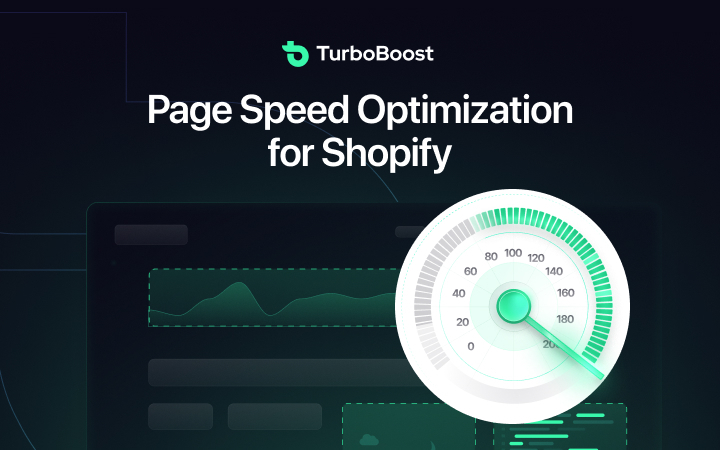Congratulations, your first Shopify online store is all up and running. The site looks beautiful, and you have some great products, too. Obviously, you’re hoping for some good sales. But wait, is that enough?
Today, customers are spoiled with choices, and bounce rates are as high as 43% for eCommerce brands. So, you need to offer a great customer experience that wows your customers. While there are a lot of factors that contribute to this, page speed is an important parameter to consider.
Your page should load fast, or else you’ll lose your customers to your competitors. But how do you go about page speed optimization on Shopify if you’re a first-time user? Well, this guide has got you covered.
What is Shopify page speed optimization?
Page speed optimization is the strategy to help you improve your page load speed. Page speed optimization, also known as store performance optimization, aims to load your eCommerce store quickly before potential customers become frustrated and bounce off.
Why is Shopify page speed optimization important?
Page speed optimization is important because the faster your store loads, the lesser the bounce rate of frustrated customers. This will reduce the instances of abandoning the store.
Even an improvement of 0.1 seconds can deeply impact your conversion. A report by Deloitte mentions that retail conversions improved by 8.4% when page speed optimization was improved by 0.1 seconds. This means that the customers spent 10% more time in the store.
Another research report proves that stores that open within one second have a 2.5 times higher conversion rate than those that load within five seconds.
Slow-loading stores also negatively affect the searchability and SEO rank of the store. Remember, Google prioritizes pages that have strong web crawl vitals. Plus, if you’re planning to run paid ads for your store, you will end up paying more as slow landing pages result in a low Google Ads Quality score.
What is the average page speed of eCommerce sites?
In 2023, the average page load time of eCommerce sites is 2.5 seconds on desktop and 8.6 seconds on mobile.
Common factors that impact page speed
There are various factors that can impact your page speed. Knowing these factors will help you to optimize your page speed better. Let’s look at some of the common factors.
The platform
Your eCommerce store is hosted on a platform, and each platform takes some time to load. If your platform is taking too much time, consider having a word with your platform provider about improving the backend so that the store can load quickly.
Hosting
Page speed also depends on the eCommerce hosting platform, especially during high-traffic days. Sites crashing during Black Friday sales are not unknown. Remember, 60 minutes of downtime for your eCommerce store can cost more than USD 300,000.
While choosing your hosting platform, remember to look for platforms that offer bandwidth to scale during peak season sales. Also, research projected traffic and peak load so that your shop doesn’t crash during peak sale time.
Remember, before any major sale event like a Black Friday sale or seasonal sales, ask your platform provider to be prepared to handle traffic spikes.
Third-party apps
Plug-ins are useful for your eCommerce store, but using too many third-party plugins can slow down the speed of the store. Do a review of your site from time to time to check if you’re using too many third-party apps; perhaps you installed them to experiment and forgot to remove them. So take a stock, and remove the ones that are not in use.
While installing new apps, pause for a minute and ask what values they are going to add to your store. Does it outweigh the possibility of slowing down the store?
Site architecture
The architecture of an eCommerce store is not simple. And that’s understandable because to function properly, the store has to constantly communicate with its users and with the browser. And it just gets more complex as you scale.
To improve site architecture and speed, you may want to consider headless commerce. In simple language, it separates the front and back end instead of overloading the browser with too many coding snippets.
How do you know your Shopify store page speed?
Different speed testing tools use different scoring methods. So select a tool that offers page load time and select a specific time marker. For example, “time to the first byte” can be a commonly used marker.
You can try these speed tests to get an idea of the page speed. But remember to keep a balance of your store speed with building a user interface that takes care of optimizing the customer’s journey, too.
How do you optimize your page speed?
Now that we understand the various factors that can slow down page speed let’s look at some of the ways to optimize your page speed.
1. Use content delivery network (CDN)
CDN, or content delivery network, is a group of servers spread across the world that distributes content delivery load through the server located closest to your user’s location. Thus, it improves the local user experience. It’s a non-negotiable ingredient that every eCommerce store must have.
2. Don’t go overboard with theme adjustment
Store appearance is important as it determines if the visitor will engage with the store. First impressions are always on design, and visitors decide in a few moments if they will engage or drop off. But a beautiful theme can slow down the page load time because, most of the time, beautiful themes are cluttered with excessive codes and graphs. So, choose a theme that’s clean, pleasant on the eyes, and fast to load.
3. Quick category page views
Enable quick category page views with pop-ups that display a product. This way, the visitor will save time visiting the product page to view the product. They can directly do so from the pop-up.
4. Chuck out redundant pop-ups
While pop-ups help engage first-time visitors by displaying discounts and special offers, too many flashy graphics can reduce the speed of the store. Plus, it may distract the visitor as well. So, should you use a pop-up or not?
Have fixed parameters around pop-up usage to reduce shop speed delays. For example, creating pop-up triggers can be helpful. You may also remove all the redundant pop-ups.
5. Optimize image size
Images have an important role in the success of your Shopify store. They do justice to the products, but they are one of the main reasons for a slow Shopify store.
Thus, Shopify image optimization comes to the rescue. Get the right image size with image compression and improve your store loading speed.
6. Go for system fonts
Custom fonts may look fancy on your Shopify store, but sometimes, they can slow down the store speed because the browser will need to download the script. Using system fonts is a good idea because these fonts are already preloaded in the system, so systems don’t need to download them separately.
7. Go for the Hero layout
Sliders and carousels on the home page may look attractive, but they have low click-through rates, they create issues in mobile responsiveness, and above all, they increase the page load time.
Instead, go for static hero images with a clear call to action. This will speed up the store speed, and you may also see better conversions.
8. Fix broken links
Nothing can frustrate your customer more than a broken link. Plus, broken links and redirects delay the page load time too. So, fix all those broken links. This is how you can go about it:
- Find all the broken links where a store page connects to a broken URL
- Remove the links or replace them with live pages
- Check the page load time now
9. Host videos externally
While it’s a great idea to showcase your product with videos from every possible angle, it can significantly slow down your store speed. Instead, you may host all the videos externally on YouTube or a similar hosting platform. You can then embed the video on your product page. That way, visitors will not have to download the video from your website every time they want to watch it.
10. Include static image
GIFs are fun to have, and they improve page engagement and product conversions. But if not optimized, GIFs can significantly reduce the page speed. So you can either include more static images or compress the GIFs using lossy compression. You may also consider converting them to MP4 files or HTML5.
11. Reduce HTTP requests
Use the HTTP request checker tool to find out how many HTTPS requests your page makes. You can reduce the request to improve your page speed. Some of the measures that you can take:
- Combine all JavaScripts
- Combine and inline CSS scripts
- Change images to Base 64 code
- Reduce the number of social buttons
12. Use Google Tag Manager
If you’re using different tracking codes for Google Analytics, AdWords, etc, on your end and sharing them with the developer, it might be time-consuming. This will also slow down your page speed. A Google Tag Manager can improve your page speed by storing all the tags in one place.
Key Takeaway
Once your Shopify store is up and running, your top priority is to keep the page optimized for speed. You should proactively review all aspects of it and optimize it before you start seeing a dip in the numbers.
Remember, every little change or update can impact the page speed. Implement the tips discussed to keep your page speed optimized. Not sure where to start? Try TurboBoost, which can help you with proactive page speed optimization.


